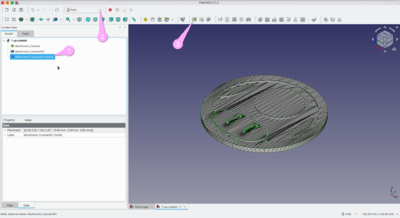IndyMill: Difference between revisions
Jump to navigation
Jump to search
| Line 15: | Line 15: | ||
# Install Arduino IDE 1.x (not 2.x!) | # Install Arduino IDE 1.x (not 2.x!) | ||
# Setup board type | # Setup board type | ||
# Setup serial/USB-connection (you might want to add your user to group <tt>dialout</tt> to allow accessing <code>/dev/ttyUSB0</code>… | # Setup serial/USB-connection (you might want to add your user to group <tt>dialout</tt> to allow accessing <code>/dev/ttyUSB0</code>…) | ||
# Download as .zip: https://github.com/gnea/grbl | # Download as .zip: https://github.com/gnea/grbl | ||
# Extract zip | # Extract zip | ||
Revision as of 14:19, 14 February 2024
About
Somewhere in 2022 I decided I wanted a CNC machine. I decided to build an IndyMill.
Project website: https://indystry.cc/indymill/
Ordering
TBD
Building
TBD
Setting up GRBL
| 🛑 | Dies might be a bad idea, since GRBL has been abandoned since 2019… |
- Install Arduino IDE 1.x (not 2.x!)
- Setup board type
- Setup serial/USB-connection (you might want to add your user to group dialout to allow accessing
/dev/ttyUSB0…) - Download as .zip: https://github.com/gnea/grbl
- Extract zip
- Open Arduino IDE
Sketch →
Library Import as .ZIP → select grbl-master/grbl
File → Examples → grbl → grblUpload
Testing Connection and GRBL-Settings
- Download CNCjs-AppImage: https://cnc.js.org/
- Launch it, set Connection parameters (device / speed)
- Enter something like this:
- Get current settings with
$$
CNCjs 1.10.3 [Grbl]
Connected to /dev/ttyUSB0 with a baud rate of 115200
Grbl 1.1h ['$' for help]
client> $$
$0=10 (Step pulse time, microseconds)
$1=25 (Step idle delay, milliseconds)
$2=0 (Step pulse invert, mask)
$3=0 (Step direction invert, mask)
$4=0 (Invert step enable pin, boolean)
$5=0 (Invert limit pins, boolean)
$6=0 (Invert probe pin, boolean)
$10=1 (Status report options, mask)
$11=0.010 (Junction deviation, millimeters)
$12=0.002 (Arc tolerance, millimeters)
$13=0 (Report in inches, boolean)
$20=0 (Soft limits enable, boolean)
$21=0 (Hard limits enable, boolean)
$22=0 (Homing cycle enable, boolean)
$23=0 (Homing direction invert, mask)
$24=25.000 (Homing locate feed rate, mm/min)
$25=500.000 (Homing search seek rate, mm/min)
$26=250 (Homing switch debounce delay, milliseconds)
$27=1.000 (Homing switch pull-off distance, millimeters)
$30=1000 (Maximum spindle speed, RPM)
$31=0 (Minimum spindle speed, RPM)
$32=0 (Laser-mode enable, boolean)
$100=250.000 (X-axis travel resolution, step/mm)
$101=250.000 (Y-axis travel resolution, step/mm)
$102=250.000 (Z-axis travel resolution, step/mm)
$110=500.000 (X-axis maximum rate, mm/min)
$111=500.000 (Y-axis maximum rate, mm/min)
$112=500.000 (Z-axis maximum rate, mm/min)
$120=10.000 (X-axis acceleration, mm/sec^2)
$121=10.000 (Y-axis acceleration, mm/sec^2)
$122=10.000 (Z-axis acceleration, mm/sec^2)
$130=200.000 (X-axis maximum travel, millimeters)
$131=200.000 (Y-axis maximum travel, millimeters)
$132=200.000 (Z-axis maximum travel, millimeters)
ok
- Change settings as described in Nikodem's manual:
$1=255
ok
$100=640
ok
$101=640
ok
$102=400
ok
$110=1000
ok
$111=1000
ok
$112=1000
ok
$120=80
ok
$121=80
ok
$122=80
ok
Work with CAD- and CAM-Software
Converting STL to solids in FreeCAD
See also: https://forum.freecad.org/viewtopic.php?t=14136
- Open the STL file
- Select object
Part → Create shape from mesh
- Select new object
Part → Converte to solid
Create GCODE with FreeCAD
See also
Do:
- Launch FreeCAD
- Make sure you have already created proper solids!
- Make sure units are ok:
Preferences → General → Unit System → Metric small parts & CNC
- Create Job:
- Links
- TBD
- Footnotes:
